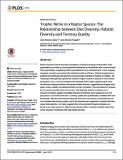Por favor, use este identificador para citar o enlazar a este item:
http://hdl.handle.net/10261/122356COMPARTIR / EXPORTAR:
 SHARE SHARE
 CORE
BASE CORE
BASE
|
|
| Visualizar otros formatos: MARC | Dublin Core | RDF | ORE | MODS | METS | DIDL | DATACITE | |

| Título: | Trophic niche in a raptor species: The relationship between diet diversity, habitat diversity and territory quality |
Autor: | Navarro-López, Juan CSIC; Fargallo, Juan A. CSIC ORCID | Fecha de publicación: | 5-jun-2015 | Editor: | Public Library of Science | Citación: | PLoS ONE 10(6): e0128855 (2015) | Resumen: | © 2015 Navarro-López, Fargallo. This is an open access article distributed under the terms of the Creative Commons Attribution License, which permits unrestricted use, distribution, and reproduction in any medium, provided the original author and source are credited. Recent research reports that many populations of species showing a wide trophic niche (generalists) are made up of both generalist individuals and individuals with a narrow trophic niche (specialists), suggesting trophic specializations at an individual level. If true, foraging strategies should be associated with individual quality and fitness. Optimal foraging theory predicts that individuals will select the most favourable habitats for feeding. In addition, the >landscape heterogeneity hypothesis> predicts a higher number of species in more diverse landscapes. Thus, it can be predicted that individuals with a wider realized trophic niche should have foraging territories with greater habitat diversity, suggesting that foraging strategies, territory quality and habitat diversity are inter-correlated. This was tested for a population of common kestrels Falco tinnunculus. Diet diversity, territory occupancy (as a measure of territory quality) and habitat diversity of territories were measured over an 8-year period. Our results show that: 1) territory quality was quadratically correlated with habitat diversity, with the best territories being the least and most diverse; 2) diet diversity was not correlated with territory quality; and 3) diet diversity was negatively correlated with landscape heterogeneity. Our study suggests that niche generalist foraging strategies are based on an active search for different prey species within or between habitats rather than on the selection of territories with high habitat diversity. | URI: | http://hdl.handle.net/10261/122356 | DOI: | 10.1371/journal.pone.0128855 | Identificadores: | doi: 10.1371/journal.pone.0128855 issn: 1932-6203 |
| Aparece en las colecciones: | (MNCN) Artículos |
Ficheros en este ítem:
| Fichero | Descripción | Tamaño | Formato | |
|---|---|---|---|---|
| PLoS ONE 10(6) e0128855.pdf | 11,2 MB | Adobe PDF |  Visualizar/Abrir |
CORE Recommender
PubMed Central
Citations
7
checked on 19-abr-2024
SCOPUSTM
Citations
21
checked on 16-abr-2024
WEB OF SCIENCETM
Citations
20
checked on 25-feb-2024
Page view(s)
270
checked on 18-abr-2024
Download(s)
276
checked on 18-abr-2024

